Concrete Made with Iron Ore Tailings as a Fine Aggregate: A Step towards Sustainable Concrete
Abstract
:1. Introduction
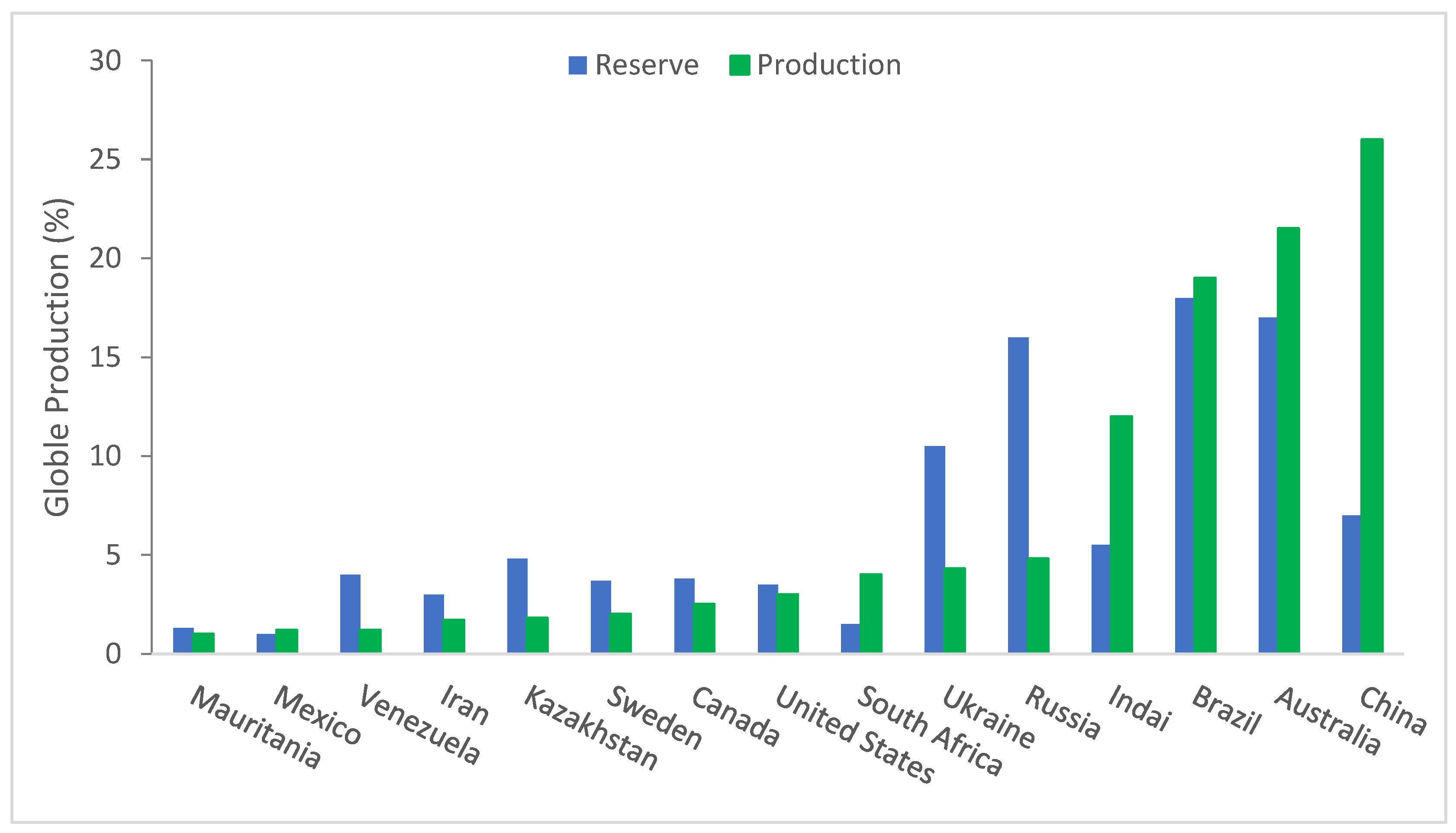
2. Physical and Chemical Properties
| Authors | [37] | [46] | [47] | [48] |
|---|---|---|---|---|
| SiO2 | 52.06 | 70.32 | 72.84 | 56 |
| Al2O3 | 17.14 | 5.10 | 4.74 | 10 |
| Fe2O3 | 9.13 | 10.93 | 8.88 | 8.30 |
| MgO | 3.68 | 4.51 | 6.06 | - |
| CaO | 12.75 | 4.71 | 5.05 | 4.30 |
| Na2O | 0.97 | 1.30 | - | - |
| K2O | 0.30 | 1.14 | - | 1.50 |
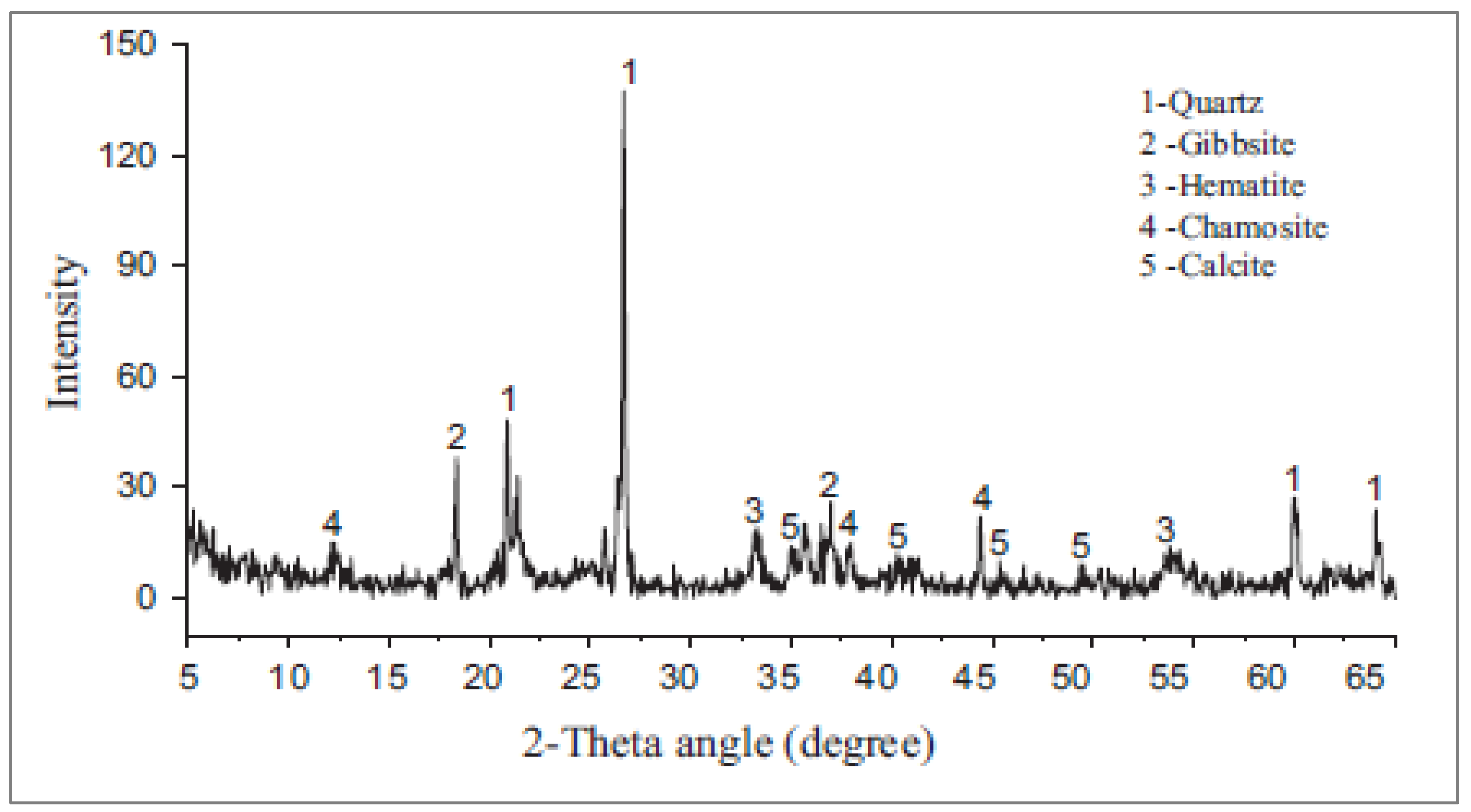
3. Fresh Properties
3.1. Slump Flow
| Reference | Iron Ore Tailing (IOT) | Slump (mm) | Remarks |
|---|---|---|---|
| [46] | 0%, 25%, 35%, and 45% | 195, 180, 175, and 170 | Decreased |
| [36] | 0%, 10%, 20%, 30%, 40%, and 50% | 45, 45, 45, 46, and 32 | No effect up 40% but 50% substitution caused decrease |
| [47] | 0%, 20%, 40%, 60%, 80%, and 100% | 220, 210, 190, 185, 170, and 160 | Decreased |
| [49] | 0%, 10%, 20%, 30%, 40%, and 50% | 67, 55, 38, 25, 25, and 23 | Decreased |
| [55] | 0%, 10%, 20%, 30%, and 40% | 750, 758, 772, 783, and 791 | Increased |
| [56] | 0%, 10%, 20%, and 30% | 127, 140, 152, and 200 | Increased |
| [54] | 0%, 6%, 12%, 18%, 24%, and 30% | 65, 63, 60, 58, 57, and 55 | Decreased |
| [57] | 0%, 10%, 20%, 30%, and 40% | 81, 79, 67, 59, and 53 | Decreased |
| [41] | 0%, 20%, 40%, 60%, 80%, and 100% | 70, 130, 115, 70, 95, and 70 | Increased up to 80% substation |
| [58] | 0%, 5%, 7%, 10%, 13%, 15%, 17%, 20%, 25%, and 30% | 100, 85, 70, 64, 56, 55, 48, 44, 30, and 25 | Decreased |
| [50] | 0%, 10%, 20%, 30%, 40%, 50%, and 60% | 50, 55, 55, 60, 60, 65, and 75 | Increased |
3.2. Bleeding
3.3. Compacting Factor
4. Mechanical Strength
4.1. Compressive Strength (CS)
| Reference | Iron Ore Tailing (IOT) | Compression Strength (MPa) |
|---|---|---|
| [37] | 0%, 20%, 40%, 60%, 80%, and 100% | 7 Days |
| 78, 85, 80, 75, 72, and 70 | ||
| 28 Days | ||
| 95, 92, 87, 85, 83, and 81 | ||
| [46] | 0%, 25%, 35%, and 45% | 3 Days |
| 16, 15, 17, and 14 | ||
| 7 Days | ||
| 28, 27, 30, and 25 | ||
| 28 Days | ||
| 39, 38, 40, and 35 | ||
| [36] | 0%, 10%, 20%, 30%, 40%, and 50% | 7 Days |
| 40, 41, 39, 38, 37, and 35 | ||
| 28 Days | ||
| 53, 55, 56, 53, 52, and 50 | ||
| 56 Days | ||
| 57, 60, 65, 57, 56, and 55 | ||
| [62] | Replacement with cement 0%, 0.4%, 0.8%, and 1.2% | 75, 58, 50, and 53 |
| [40] | 0%, 10%, 20%, and 80% | 7 Days |
| 57.6, 55.6, 43.4, and 43 | ||
| 70 Days | ||
| 62.6, 62, 51, and 48.9 | ||
| [47] | 0%, 20%, 40%, 60%, 80%, and 100% | 7 Days |
| 88, 92, 95, 90, 87, and 83 | ||
| 28 Days | ||
| 105, 112, 120, 111, 104, and 95 | ||
| [48] | 0%, 25%, 50%, 75%, and 100% | 7 Days |
| 32, 31.9, 30.2, 32.8, and 29.3 | ||
| 14 Days | ||
| 34.3, 35.7, 35.3, 35.1, and 33.1 | ||
| 28 Days | ||
| 38, 42.9, 42, 41.9, and 38.5 | ||
| [50] | 0%, 10%, 20%, 30%, 40%, 50%, and 60% | 7 Days |
| 23.7, 25.1, 26.9, 28.9, 29.8, and 28.7 | ||
| 28 Days | ||
| 40.8, 40.1, 41.5, 42.8, 40.1, 38.6, and 35.8 | ||
| 90 Days | ||
| 41.2, 41.9, 42.6, 43.1, 39.8, 37.8, and 35.1 | ||
| [49] | 0%, 10%, 20%, 30%, 40% and 50% | 3 Days |
| 23.83, 23.03, 21.65, 24.27, 26.08, and 25.94 | ||
| 7 Days | ||
| 27.17, 32.92, 34.15, 35.02, 32.48, and 38.91 | ||
| 28 Days | ||
| 38.58, 49.28, 50.27, 21.59, 55.10, and 53.76 | ||
| 56 Days | ||
| 41.05, 50.22, 53.13, 55.13, 55.13, 56.59, and 54.10 | ||
| [63] | 0%, 10%, 20%, 30%, 40%, and 50% | 7 Days |
| 37, 30, 33, 33, 30, 28, and 25 | ||
| 28 Days | ||
| 46, 46, 47, 50, 45, 44, and 43 | ||
| [55] | 0%, 10%, 20%, 30%, and 40% | 7 Days |
| 25, 28, 32, 31, and 26 | ||
| 28 Days | ||
| 32, 32, 38, 33, and 35 | ||
| [56] | 0%, 10%, 20%, and 30% | 7 Days |
| 95, 95, 85, and 88 | ||
| 28 Days | ||
| 120, 142, 122, and 119 | ||
| [54] | 0%, 6%, 12%, 18%, 24%, and 30% | 14 Days |
| 35, 36, 39, 23, 21, and 20. | ||
| 28 Days | ||
| 39, 40, 41, 35, 28, and 25 | ||
| [57] | 0%, 10%, 20%, 30%, and 40% | 14 Days |
| 25, 33, 33, 37, and 28 | ||
| 28 Days | ||
| 30, 38, 39, 42, and 35 | ||
| [41] | 0%, 20%, 40%, 60%, 80%, and 100% | 1 Days |
| 5.68, 9.35, 5.51, 4.67, 4.43, and 2.53 | ||
| 3 Days | ||
| 24.51, 27.57, 20.70, 18.78, 15.52, and 12.53 | ||
| 7 Days | ||
| 32.28, 36.69, 31.69, 29.38, 24.04, and 20.49 | ||
| 28 Days | ||
| 43.09, 45.17, 40.44, 35.09, 32.23, and 23.39 | ||
| [58] | 0%, 5%, 7%, 10%, 13%, 15%, 17%, 20%, 25%, and 30% | 41.37, 37.48, 38.82, 38.75, 39.18, 40.07, 44.64, 40.76, and 40.20 |
| [64] | Fly Ash | 43, 46, 49, and 42 |
| 100%, 90%, 80%, 70% | ||
| IOT | ||
| 0%, 10%, 20%, and 30% |
4.2. Split Tensile Strength (TS)
4.3. Flexural Strength (FS)
5. Durability
5.1. Water Absorption
5.2. Chloride Ion—Penetration Resistance
5.3. Shrinkage
6. Microstructure (Scanning Electron Microscopy)
7. Thermal Stability
8. Cost and Environmental Evaluation
9. Conclusions
- Physical properties show that IOT particles are rough and angular, which reduce the flowability of concrete.
- The chemical composition and XRD analysis of IOT show that IOT has the ability to be utilized as a binding material.
- Fresh properties of concrete such as slump flow and compactability decrease with added IOT. However, up to 40% substitution of IOT shows that concrete has sufficient flowability and compactability. Furthermore, for higher doses, a plasticizer is recommended.
- To certain limit, mechanical strength improves with IOT substitution due to micro filling voids and pozzolanic reaction. Different researchers recommend different optimum doses. However, the typical optimum dose varies from 30 to 40%. However, a higher dose of IOT (greater 40%) adversely affects the mechanical strength of concrete.
- Compressive strength of concrete with 20% substituted IOT is 14% more than reference concrete.
- Water absorption, chloride ion penetration, and dry shrinkage decrease considerably with the substitution of IOT.
- SEM results indicate that ITZ (cracks) improved with the substitution IOT due to filling voids and pozzolanic reaction.
10. Recommendations
Author Contributions
Funding
Institutional Review Board Statement
Informed Consent Statement
Data Availability Statement
Acknowledgments
Conflicts of Interest
References
- Ahmad, J.; Zaid, O.; Siddique, M.S.; Aslam, F.; Alabduljabbar, H.; Khedher, K.M. Mechanical and Durability Characteristics of Sustainable Coconut Fibers Reinforced Concrete with Incorporation of Marble Powder. Mater. Res. Express 2021, 8, 075505. [Google Scholar] [CrossRef]
- Taskin, A.; Fediuk, R.; Grebenyuk, I.; Elkin, O.; Kholodov, A. Effective Cement Binders on Fly and Slag Waste from Heat Power Industry of the Primorsky Krai, Russian Federation. Int. J. Sci. Technol. Res. 2020, 9, 3509–3512. [Google Scholar]
- Althoey, F.; Farnam, Y. The Effect of Using Supplementary Cementitious Materials on Damage Development Due to the Formation of a Chemical Phase Change in Cementitious Materials Exposed to Sodium Chloride. Constr. Build. Mater. 2019, 210, 685–695. [Google Scholar] [CrossRef]
- Smirnova, O.M.; Menéndez Pidal de Navascués, I.; Mikhailevskii, V.R.; Kolosov, O.I.; Skolota, N.S. Sound-Absorbing Composites with Rubber Crumb from Used Tires. Appl. Sci. 2021, 11, 7347. [Google Scholar] [CrossRef]
- Dolamary, P.Y.; Dilshad, J.A.F.; Arbili, M.M.; Karpuzcu, M. Validation of Feret Regression Model for Fly Ash Based Geopolymer Concrete. Polytech. J. 2018, 8, 173–189. [Google Scholar]
- Althoey, F. Compressive Strength Reduction of Cement Pastes Exposed to Sodium Chloride Solutions: Secondary Ettringite Formation. Constr. Build. Mater. 2021, 299, 123965. [Google Scholar] [CrossRef]
- Ahmad, J.; Aslam, F.; Zaid, O.; Alyousef, R.; Alabduljabbar, H. Mechanical and Durability Characteristics of Sustainable Concrete Modified with Partial Substitution of Waste Foundry Sand. Struct. Concr. 2021, 22, 2775–2790. [Google Scholar] [CrossRef]
- Ahmad, J.; Aslam, F.; Martinez-Garcia, R.; De-Prado-Gil, J.; Qaidi, S.M.A.; Brahmia, A. Effects of Waste Glass and Waste Marble on Mechanical and Durability Performance of Concrete. Sci. Rep. 2021, 11, 21525. [Google Scholar] [CrossRef]
- Dolage, D.A.R.; Dias, M.G.S.; Ariyawansa, C.T. Offshore Sand as a Fine Aggregate for Concrete Production. Br. J. Appl. Sci. Technol. 2013, 3, 813–825. [Google Scholar] [CrossRef]
- Amin, S.K.; Allam, M.E.; Garas, G.L.; Ezz, H. A Study of the Chemical Effect of Marble and Granite Slurry on Green Mortar Compressive Strength. Bull. Natl. Res. Cent. 2020, 44, 19. [Google Scholar] [CrossRef]
- Abdallah, S.; Fan, M. Characteristics of Concrete with Waste Glass as Fine Aggregate Replacement. Int. J. Eng. Tech. Res. 2014, 2, 11–17. [Google Scholar]
- Corinaldesi, V.; Gnappi, G.; Moriconi, G.; Montenero, A. Reuse of Ground Waste Glass as Aggregate for Mortars. Waste Manag. 2005, 25, 197–201. [Google Scholar] [CrossRef]
- Arbili, M.M.; Ghaffoori, F.K.; Awlla, H.A.; Alzeebaree, R.; Ibrahim, T.K. Utilization of Styrene-Butadiene Rubber (SBR) Polymer Replacement of Fine Aggregate in Concrete. In Proceedings of the IOP Conference Series: Earth and Environmental Science; IOP Publishing: Bristol, UK, 2021; Volume 856, p. 12032. [Google Scholar]
- Shoeibi, S.; Kargarsharifabad, H.; Rahbar, N. Effects of Nano-Enhanced Phase Change Material and Nano-Coated on the Performance of Solar Stills. J. Energy Storage 2021, 42, 103061. [Google Scholar] [CrossRef]
- Ahmad, J.; Majdi, A.; Deifalla, A.F.; Isleem, H.F.; Rahmawati, C. Concrete Made with Partially Substitutions of Copper Slag (CPS): State of the Art Review. Materials 2022, 15, 5196. [Google Scholar] [CrossRef] [PubMed]
- Ahmad, J.; Majdi, A.; Babeker Elhag, A.; Deifalla, A.F.; Soomro, M.; Isleem, H.F.; Qaidi, S. A Step towards Sustainable Concrete with Substitution of Plastic Waste in Concrete: Overview on Mechanical, Durability and Microstructure Analysis. Crystals 2022, 12, 944. [Google Scholar] [CrossRef]
- Mermerdaş, K.; Arbili, M.M. Explicit Formulation of Drying and Autogenous Shrinkage of Concretes with Binary and Ternary Blends of Silica Fume and Fly Ash. Constr. Build. Mater. 2015, 94, 371–379. [Google Scholar] [CrossRef]
- Monteiro, P. Concrete: Microstructure, Properties, and Materials; McGraw-Hill Publishing: New York, NY, USA, 2006; ISBN 1281080799. [Google Scholar]
- Zhang, S.; Xue, X.; Liu, X.; Duan, P.; Yang, H.; Jiang, T.; Wang, D.; Liu, R. Current Situation and Comprehensive Utilization of Iron Ore Tailing Resources. J. Min. Sci. 2006, 42, 403–408. [Google Scholar] [CrossRef]
- Du Plessis, C. A Strategic Framework for Sustainable Construction in Developing Countries. Constr. Manag. Econ. 2007, 25, 67–76. [Google Scholar] [CrossRef]
- Kansal, K.G.R. Waste Glass Powder as a Partial Replacement of PPC. Int. J. Sci. Res. 2016, 5, 1414–1418. [Google Scholar]
- Oh, D.-Y.; Noguchi, T.; Kitagaki, R.; Park, W.-J. CO2 Emission Reduction by Reuse of Building Material Waste in the Japanese Cement Industry. Renew. Sustain. Energy Rev. 2014, 38, 796–810. [Google Scholar] [CrossRef]
- Alvee, A.R.; Malinda, R.; Akbar, A.M.; Ashar, R.D.; Rahmawati, C.; Alomayri, T.; Raza, A.; Shaikh, F.U.A. Experimental Study of the Mechanical Properties and Microstructure of Geopolymer Paste Containing Nano-Silica from Agricultural Waste and Crystalline Admixtures. Case Stud. Constr. Mater. 2022, 16, e00792. [Google Scholar] [CrossRef]
- Althoey, F.; El-Aal, A.K.A.; Shoukry, H.; Hakeem, I. Performance of Cement Mortars Containing Clay Exposed to High Temperature. Arab. J. Sci. Eng. 2021, 47, 591–599. [Google Scholar] [CrossRef]
- Naik, T.R. Sustainability of Concrete Construction. Pract. Period. Struct. Des. Constr. 2008, 13, 98–103. [Google Scholar] [CrossRef]
- Vigneshpandian, G.V.; Shruthi, E.A.; Venkatasubramanian, C.; Muthu, D. Utilisation of Waste Marble Dust as Fine Aggregate in Concrete. IOP Conf. Ser. Earth Environ. Sci. 2017, 80, 012007. [Google Scholar] [CrossRef] [Green Version]
- Imbabi, M.S.; Carrigan, C.; McKenna, S. Trends and Developments in Green Cement and Concrete Technology. Int. J. Sustain. Built Environ. 2012, 1, 194–216. [Google Scholar] [CrossRef]
- Singh Shekhawat, B.; Aggarwal, V. Utilisation of Waste Glass Powder in Concrete-A Literature Review. Int. J. Innov. Res. Sci. Eng. Technol. 2007, 3297, 2319–8753. [Google Scholar]
- Nelson, J.; Grayson, D. World Business Council for Sustainable Development (WBCSD). In Corporate Responsibility Coalitions; Routledge: Abingdon, UK, 2017; pp. 300–317. [Google Scholar]
- Humphreys, D. Long-Run Availability of Mineral Commodities. Miner. Econ. 2013, 26, 1–11. [Google Scholar] [CrossRef]
- Müller, N.; Harnisch, J. How to Turn Around the Trend of Cement Related Emissions in the Developing World; WWF—Lafarge Conservation Partnership: Gland, Switzerland, 2008. [Google Scholar]
- Smith, R.A.; Kersey, J.R.; Griffiths, P.J. The Construction Industry Mass Balance: Resource Use, Wastes and Emissions. Construction 2002, 4, 680. [Google Scholar]
- Du, H.; Tan, K.H. Concrete with Recycled Glass as Fine Aggregates. ACI Mater. J. 2014, 111, 47–57. [Google Scholar] [CrossRef]
- Ahmad, J.; Martínez-García, R.; De-Prado-Gil, J.; Irshad, K.; El-Shorbagy, M.A.; Fediuk, R.; Vatin, N.I. Concrete with Partial Substitution of Waste Glass and Recycled Concrete Aggregate. Materials 2022, 15, 430. [Google Scholar] [CrossRef]
- Hajimohammadi, A.; Ngo, T.; Kashani, A. Sustainable One-Part Geopolymer Foams with Glass Fines versus Sand as Aggregates. Constr. Build. Mater. 2018, 171, 223–231. [Google Scholar] [CrossRef]
- Bangalore Chinnappa, G.; Karra, R.C. Experimental and Statistical Evaluations of Strength Properties of Concrete with Iron Ore Tailings as Fine Aggregate. J. Hazard. Toxic Radioact. Waste 2020, 24, 4019038. [Google Scholar] [CrossRef]
- Zhao, S.; Fan, J.; Sun, W. Utilization of Iron Ore Tailings as Fine Aggregate in Ultra-High Performance Concrete. Constr. Build. Mater. 2014, 50, 540–548. [Google Scholar] [CrossRef]
- Alwaeli, M.; Nadziakiewicz, J. Recycling of Scale and Steel Chips Waste as a Partial Replacement of Sand in Concrete. Constr. Build. Mater. 2012, 28, 157–163. [Google Scholar] [CrossRef]
- Ismail, Z.Z.; Al-Hashmi, E.A. Reuse of Waste Iron as a Partial Replacement of Sand in Concrete. Waste Manag. 2008, 28, 2048–2053. [Google Scholar] [CrossRef] [PubMed]
- Filho, J.N.S.; Da Silva, S.N.; Silva, G.C.; Mendes, J.C.; Peixoto, R.A.F. Technical and Environmental Feasibility of Interlocking Concrete Pavers with Iron Ore Tailings from Tailings Dams. J. Mater. Civ. Eng. 2017, 29, 4017104. [Google Scholar] [CrossRef]
- Liu, W.Y.; Xu, X.L.; An, Y.Y. Study on the Sprayed Concrete with Iron Tailings. In Proceedings of the Advanced Materials Research; Trans Tech Publications: Bäch, Switzerland, 2012; Volume 347, pp. 1939–1943. [Google Scholar]
- Huang, X.; Ranade, R.; Ni, W.; Li, V.C. Development of Green Engineered Cementitious Composites Using Iron Ore Tailings as Aggregates. Constr. Build. Mater. 2013, 44, 757–764. [Google Scholar] [CrossRef]
- Ma, B.; Cai, L.; Li, X.; Jian, S. Utilization of Iron Tailings as Substitute in Autoclaved Aerated Concrete: Physico-Mechanical and Microstructure of Hydration Products. J. Clean. Prod. 2016, 127, 162–171. [Google Scholar] [CrossRef]
- Haque, N. Life Cycle Assessment of Iron Ore Mining and Processing. In Iron Ore; Elsevier: Amsterdam, The Netherlands, 2022; pp. 691–710. ISBN 9780128202265. [Google Scholar]
- Ahmad, J.; Zaid, O.; Shahzaib, M.; Abdullah, M.U.; Ullah, A.; Ullah, R. Mechanical Properties of Sustainable Concrete Modified by Adding Marble Slurry as Cement Substitution. AIMS Mater. Sci. 2021, 8, 343–358. [Google Scholar] [CrossRef]
- Tian, Z.; Zhao, Z.; Dai, C.; Liu, S. Experimental Study on the Properties of Concrete Mixed with Iron Ore Tailings. Adv. Mater. Sci. Eng. 2016, 2016, 8606505. [Google Scholar] [CrossRef]
- Zhang, W.; Gu, X.; Qiu, J.; Liu, J.; Zhao, Y.; Li, X. Effects of Iron Ore Tailings on the Compressive Strength and Permeability of Ultra-High Performance Concrete. Constr. Build. Mater. 2020, 260, 119917. [Google Scholar] [CrossRef]
- Shettima, A.U.; Hussin, M.W.; Ahmad, Y.; Mirza, J. Evaluation of Iron Ore Tailings as Replacement for Fine Aggregate in Concrete. Constr. Build. Mater. 2016, 120, 72–79. [Google Scholar] [CrossRef]
- Kumar, B.N.S.; Suhas, R.; Shet, S.U.; Srishaila, J.M. Utilization of Iron Ore Tailings as Replacement to Fine Aggregates in Cement Concrete Pavements. Int. J. Res. Eng. Technol. 2014, 3, 369–376. [Google Scholar]
- Finih, P.K.B.Z.U.; Odpadkov, A.I.Z.; Njihove, E.R.I.N.; Lastnosti, M. Preparations of Composite Concretes Using Iron Ore Tailings as Fine Aggregates and Their Mechanical Behavior. Mater. Tehnol. 2019, 53, 467–472. [Google Scholar]
- ASTM, C. 33/C33M; Standard Specification for Concrete Aggregates B. ASTM Standard: West Conshohocken, PA, USA, 2008; Volume 4, pp. 498–505.
- Arum, C.; Owolabi, A.O. Suitability of iron ore tailings and quarry dust as fine aggregates for concrete production. J. Appl. Sci. Technol. 2012, 17, 46–52. [Google Scholar]
- Hou, Y.F. Comparison of Effect of Iron Tailing Sand and Natural Sand on Concrete Properties. In Proceedings of the Key Engineering Materials; Trans Tech Publications: Bäch, Switzerland, 2014; Volume 599, pp. 11–14. [Google Scholar]
- Krikar, M.; Gharrib Noori, H.H.I. Mechanical Properties of Concrete Using Iron Waste as a Partial Replacement of Sand. In Proceedings of the 4th International Engineering Conference on Developments in Civil & Computer Engineering Applications, Erbil, Iraq, 26–27 February 2018. [Google Scholar]
- Shetty, K.K.; Nayak, G.; Vijayan, V. Effect of Red Mud and Iron Ore Tailings on the Strength of Selfcompacting Concrete. Eur. Sci. J. 2014, 10. [Google Scholar] [CrossRef]
- Ling, G.; Shui, Z.; Gao, X.; Sun, T.; Yu, R.; Li, X. Utilizing Iron Ore Tailing as Cementitious Material for Eco-Friendly Design of Ultra-High Performance Concrete (Uhpc). Materials 2021, 14, 1829. [Google Scholar] [CrossRef]
- Oritola, S.; Saleh, A.L.; Mohd Sam, A.R. Performance of Iron Ore Tailings as Partial Replacement for Sand in Concrete. In Proceedings of the Applied Mechanics and Materials; Trans Tech Publications: Bäch, Switzerland, 2015; Volume 735, pp. 122–127. [Google Scholar]
- Sabat, V.; Shaikh, M.; Kanap, M.; Chaudhari, M.; Suryawanshi, S.; Knadgouda, K. Use of Iron Ore Tailings as a Construction Material. Int. J. Concept. Mech. Civ. Eng. 2015, 3, 1–6. [Google Scholar]
- Xiong, C.; Li, W.; Jiang, L.; Wang, W.; Guo, Q. Use of Grounded Iron Ore Tailings (GIOTs) and BaCO3 to Improve Sulfate Resistance of Pastes. Constr. Build. Mater. 2017, 150, 66–76. [Google Scholar] [CrossRef]
- Khon, K.; Korsun, V.; Ha, Q.; Volkov, A. Effect of Short-Term Heating up To+ 90 C on Deformation and Strength of High-Strength Concrete. In Proceedings of the International Scientific Conference on Energy, Environmental and Construction Engineering; Springer: Berlin/Heidelberg, Germany, 2019; pp. 585–592. [Google Scholar]
- Castel, A.; Foster, S.J. Bond Strength between Blended Slag and Class F Fly Ash Geopolymer Concrete with Steel Reinforcement. Cem. Concr. Res. 2015, 72, 48–53. [Google Scholar] [CrossRef]
- Huang, X.; Ranade, R.; Li, V.C. Feasibility Study of Developing Green ECC Using Iron Ore Tailings Powder as Cement Replacement. J. Mater. Civ. Eng 2013, 25, 923–931. [Google Scholar] [CrossRef]
- Tang, C.; Li, K.; Ni, W.; Fan, D. Recovering Iron from Iron Ore Tailings and Preparing Concrete Composite Admixtures. Minerals 2019, 9, 232. [Google Scholar] [CrossRef]
- Duan, P.; Yan, C.; Zhou, W.; Ren, D. Fresh Properties, Compressive Strength and Microstructure of Fly Ash Geopolymer Paste Blended with Iron Ore Tailing under Thermal Cycle. Constr. Build. Mater. 2016, 118, 76–88. [Google Scholar] [CrossRef]
- Ugama, T.I.; Ejeh, S.P. Iron Ore Tailing as Fine Aggregate in Mortar Used for Masonry. Int. J. Adv. Eng. Technol. 2014, 7, 1170. [Google Scholar]
- Li, G.; Chen, Y.J.; Di, H. The Study on Used Properties of Mine Tailings Sand. In Proceedings of the Advanced Materials Research; Trans Tech Publications: Bäch, Switzerland, 2014; Volume 859, pp. 87–90. [Google Scholar]
- Alzaed, A.N. Effect of Iron Filings in Concrete Compression and Tensile Strength. Int. J. Recent Dev. Eng. Technol. 2014, 3, 121–125. [Google Scholar]
- Kuranchie, F.A.; Shukla, S.K.; Habibi, D.; Mohyeddin, A. Utilisation of Iron Ore Tailings as Aggregates in Concrete. Cogent Eng. 2015, 2, 1083137. [Google Scholar] [CrossRef]
- Adedayo, S.M.; Onitiri, M.A. Tensile Properties of Iron Ore Tailings Filled Epoxy Composites. West Indian J. Eng. 2012, 35, 51–59. [Google Scholar]
- Yu, L.; Zhang, J.X.; Mu, K. Relationships between Compressive Strength and Microstructure in Mortars with Iron Ore Tailings as Fine Aggregate. In Proceedings of the Applied Mechanics and Materials; Trans Tech Publications: Bäch, Switzerland, 2012; Volume 188, pp. 211–218. [Google Scholar]
- Chan, D.; Sun, P.C. Effects of Fine Recycled Aggregate as Sand Replacement in Concrete. HKIE Trans. 2006, 13, 2–7. [Google Scholar] [CrossRef]
- Correia, J.R.; de Brito, J.; Pereira, A.S. Effects on Concrete Durability of Using Recycled Ceramic Aggregates. Mater. Struct. 2006, 39, 169–177. [Google Scholar] [CrossRef]
- Neville, A.M. Properties of Concrete; Longman: London, UK, 1995; Volume 4. [Google Scholar]
- Mermerdaş, K.; Arbili, M.M.; Ghaffoori, F.K. Statistical Analysis of the Performance of the Soft Computing Based Prediction Model for Shrinkage of Concrete Including Mineral Admixtures. ZANCO J. Pure Appl. Sci. 2016, 28, s270–s276. [Google Scholar]
- Zhou, X.M.; Slater, J.R.; Wavell, S.E.; Oladiran, O. Effects of PFA and GGBS on Early-Ages Engineering Properties of Portland Cement Systems. J. Adv. Concr. Technol. 2012, 10, 74–85. [Google Scholar] [CrossRef]
- Singh, M.; Siddique, R. Effect of Coal Bottom Ash as Partial Replacement of Sand on Properties of Concrete. Resour. Conserv. Recycl. 2013, 72, 20–32. [Google Scholar] [CrossRef]
- Feng, X.X.; Xi, X.L.; Cai, J.W.; Chai, H.J.; Song, Y.Z. Investigation of Drying Shrinkage of Concrete Prepared with Iron Mine Tailings. In Proceedings of the Key Engineering Materials; Trans Tech Publications: Bäch, Switzerland, 2011; Volume 477, pp. 37–41. [Google Scholar]
- Zhang, G.D.; Zhang, X.Z.; Zhou, Z.H.; Cheng, X. Preparation and Properties of Concrete Containing Iron Tailings/Manufactured Sand as Fine Aggregate. In Proceedings of the Advanced Materials Research; Trans Tech Publications: Bäch, Switzerland, 2014; Volume 838, pp. 152–155. [Google Scholar]
- Bai, Y.; Darcy, F.; Basheer, P.A.M. Strength and Drying Shrinkage Properties of Concrete Containing Furnace Bottom Ash as Fine Aggregate. Constr. Build. Mater. 2005, 19, 691–697. [Google Scholar] [CrossRef]
- Li, J.; Yao, Y. A Study on Creep and Drying Shrinkage of High Performance Concrete. Cem. Concr. Res. 2001, 31, 1203–1206. [Google Scholar] [CrossRef]
- Scrivener, K.L.; Bentur, A.; Pratt, P.L. Quantitative Characterization of the Transition Zone in High Strength Concretes. Adv. Cem. Res. 1988, 1, 230–237. [Google Scholar] [CrossRef]
- Zhang, T.; Yu, Q.; Wei, J.; Zhang, P. A New Gap-Graded Particle Size Distribution and Resulting Consequences on Properties of Blended Cement. Cem. Concr. Compos. 2011, 33, 543–550. [Google Scholar] [CrossRef]
- Sun, W.; Zhao, S. Characterizing the Microstructure of UHPCC with High-Volume Fly Ash Addition by Nanoindentation. In Proceedings of the 13th International Congress on the Chemistry of Cement, Madrid, Spain, 3–8 July 2011; Palomo, Á., Zaragoza, A., Agüí, J.L., Eds.; Instituto de Ciencias de la Construcción: Madrid, Spain, 2011; Volume 399. [Google Scholar]
- Chindaprasirt, P.; Paisitsrisawat, P.; Rattanasak, U. Strength and Resistance to Sulfate and Sulfuric Acid of Ground Fluidized Bed Combustion Fly Ash–Silica Fume Alkali-Activated Composite. Adv. Powder Technol. 2014, 25, 1087–1093. [Google Scholar] [CrossRef]
- Zhang, T.; Shang, S.; Yin, F.; Aishah, A.; Salmiah, A.; Ooi, T.L. Adsorptive Behavior of Surfactants on Surface of Portland Cement. Cem. Concr. Res. 2001, 31, 1009–1015. [Google Scholar] [CrossRef]
- Wei, Y.; Yao, W.; Xing, X.; Wu, M. Quantitative Evaluation of Hydrated Cement Modified by Silica Fume Using QXRD, 27Al MAS NMR, TG–DSC and Selective Dissolution Techniques. Constr. Build. Mater. 2012, 36, 925–932. [Google Scholar] [CrossRef]
- Packey, D.J. Multiproduct Mine Output and the Case of Mining Waste Utilization. Resour. Policy 2012, 37, 104–108. [Google Scholar] [CrossRef]

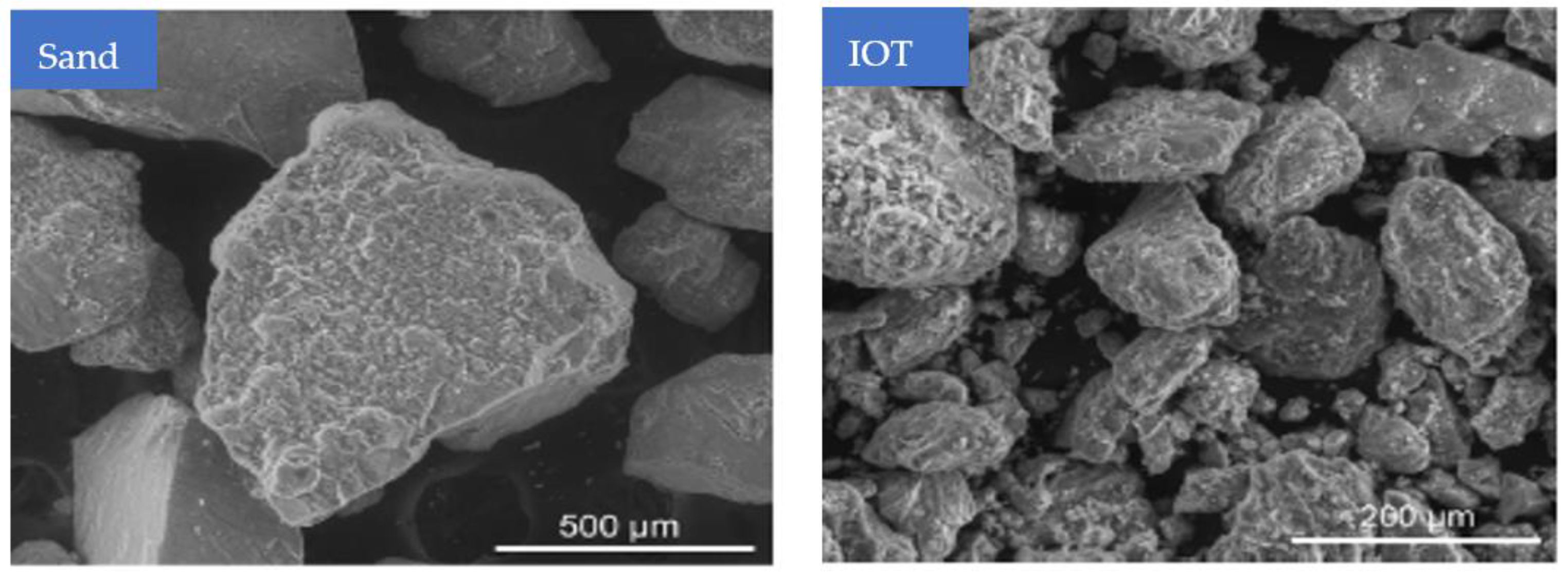
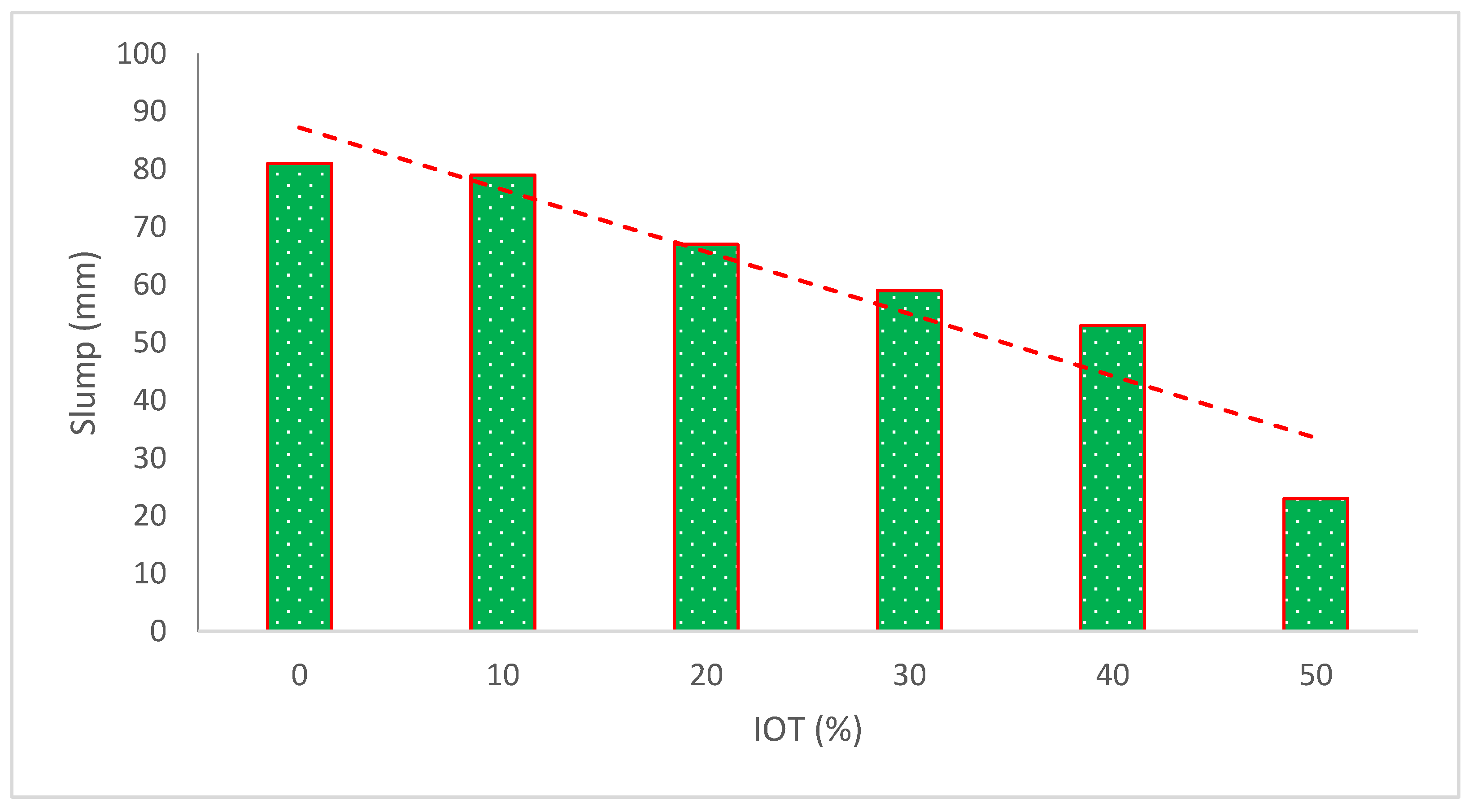


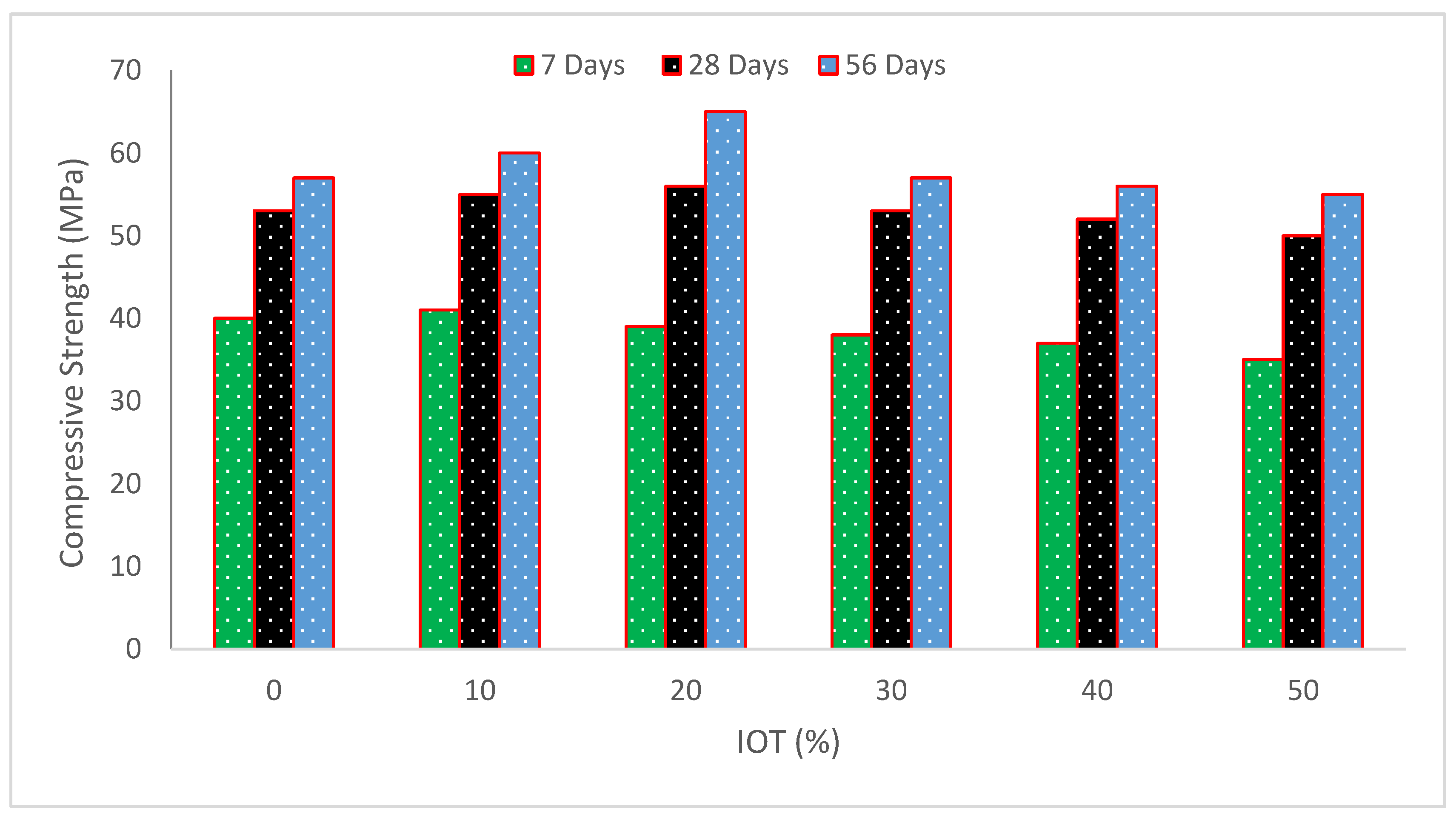


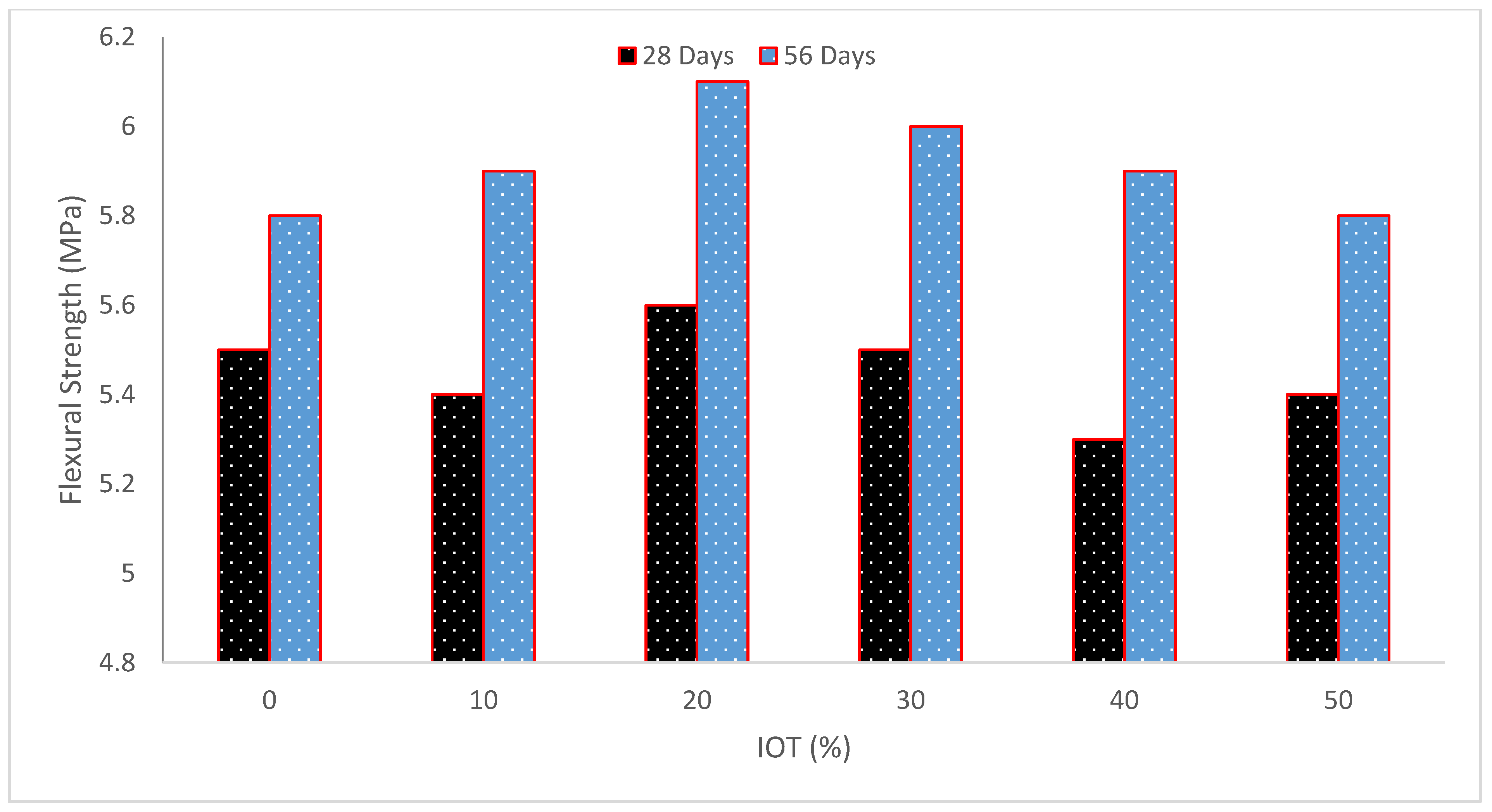
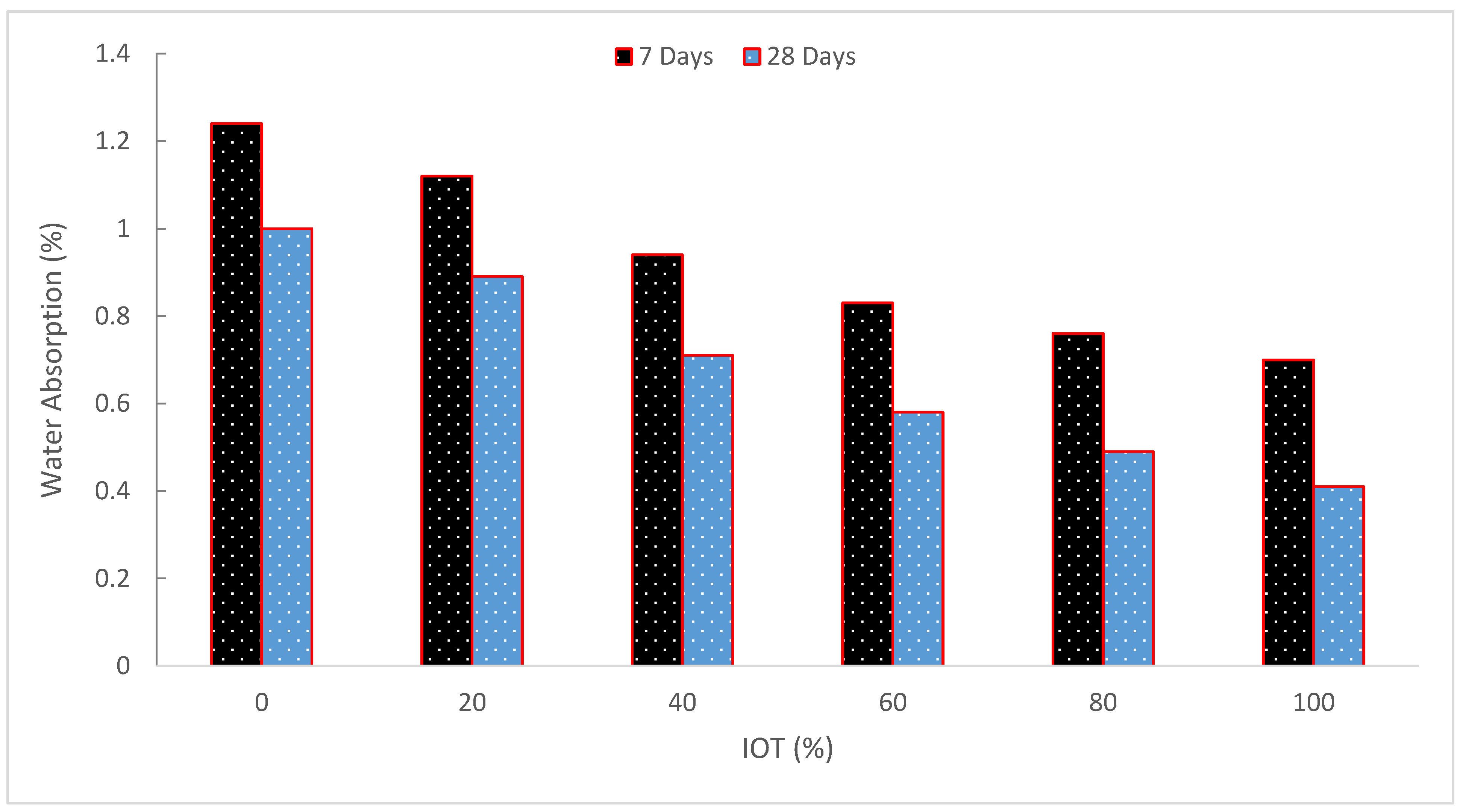
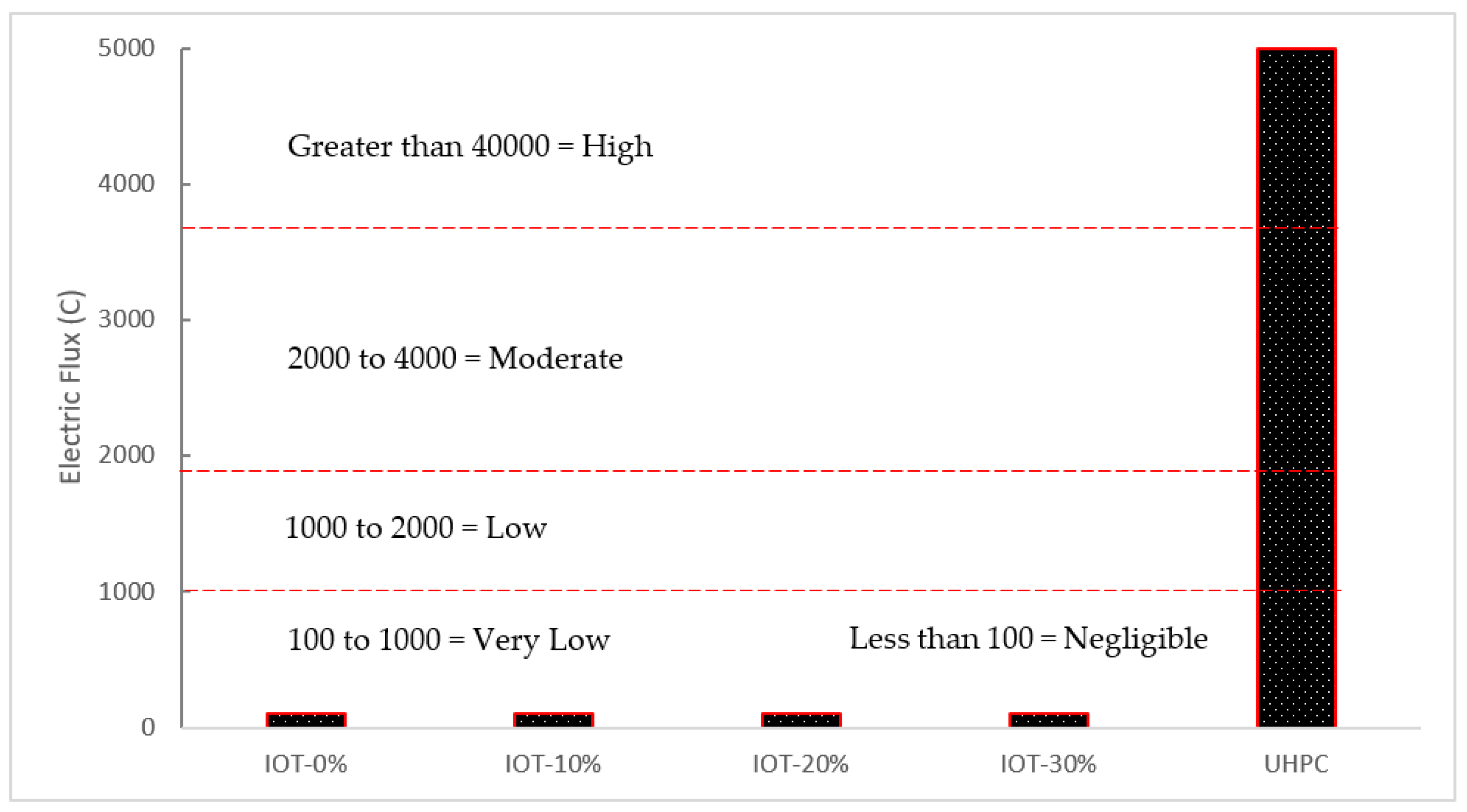



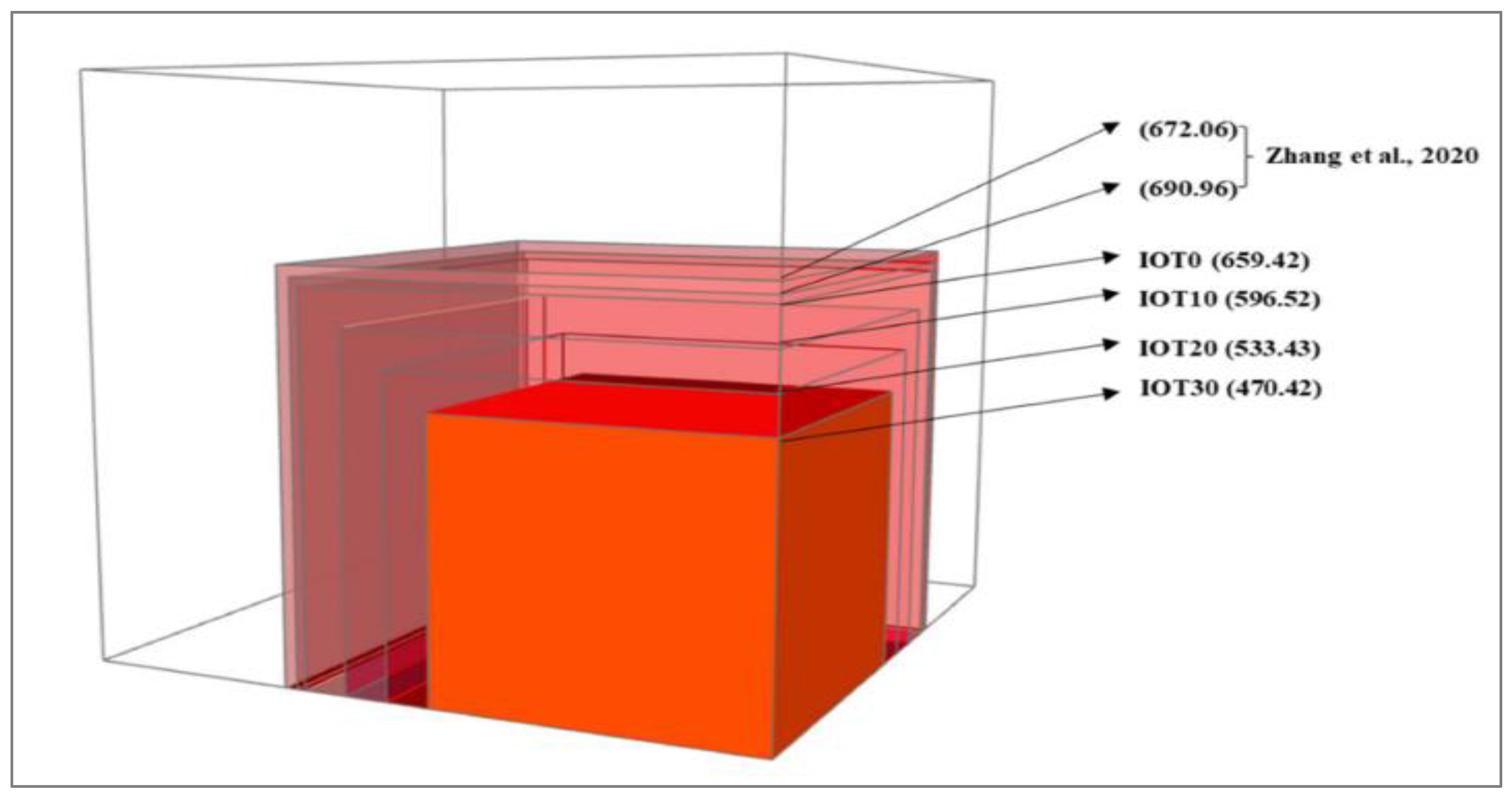
| Reference | Iron Ore Tailing (IOT) | Tensile Strength (MPa) |
|---|---|---|
| [36] | 0%, 10%, 20%, 30%, 40%, and 50% | 28 Days |
| 3.7, 4.0, 4.1, 4.0, 4.0, 4.0, and 3.8 | ||
| 56 Days | ||
| 4.1, 4.0, 4.5, 4.4, 4.2, and 4.0 | ||
| [62] | Replacement with Cement 0%, 0.4%, 0.8%, and 1.2% | 6.1, 6.0, 5.3, and 5.5 |
| [48] | 0%, 25%, 50%, 75%, and 100% | 7 Days |
| 3.1, 3.9, 3.8, 3.6, and 3.4 | ||
| 28 Days | ||
| 3.9, 4.7, 4.4, 4.2, and 4.0 | ||
| [55] | 0%, 10%, 20%, 30%, and 40% | 28 Days |
| 3.5, 3.2, 3.5, 3.1, and 3.3 | ||
| [57] | 0%, 10%, 20%, 30%, and 40% | 28 Days |
| 3.54, 3.72, 3.75, 3.91, and 4.0 | ||
| [58] | 0%, 5%, 7%, 10%, 13%, 15%, 17%, 20%, 25%, and 30% | 3.06, 2.34, 2.43, 2.67, 2.92, 2.72, 2.64, 2.75, 2.46, and 2.49 |
| [50] | 0%, 10%, 20%, 30%, 40%, 50%, and 60% | 3.8, 4.2, 5.1, 6.7, 6.3, 4.5, and 3.7 |
| Reference | Iron Ore Tailing (IOT) | Flexure Strength (MPa) |
|---|---|---|
| [37] | 0%, 20%, 40%, 60%, 80%, and 100% | 7 Days |
| 14, 16, 14, 15, 15, and 15.5 | ||
| 28 Days | ||
| 19, 18, 16, 17, 16.5, and 16 | ||
| [36] | 0%, 10%, 20%, 30%, 40%, and 50% | 28 Days |
| 5.5, 5.4, 5.6, 5.5, 5.3, and 5.4 | ||
| 56 Days | ||
| 5.8, 5.9, 6.1, 6.0, 5.9, and 5.8 | ||
| [49] | 0%, 10%, 20%, 30%, 40%, and 50% | 3 Days |
| 6.86, 6.53, 5.13, 5.27, 5, and 5.4 | ||
| 7 Days | ||
| 7.6, 6.8, 6.6, 5.5, 7.2, and 6.1 | ||
| 28 Days | ||
| 10, 8.65, 7.5, 8.8, 9.2, and 7.4 | ||
| 56 Days | ||
| 10.33, 8.67, 7.67, 8.93, 9.27, and 8 | ||
| [55] | 0%, 10%, 20%, 30%, and 40% | 28 Days |
| 6.1, 6.2, 7.1, 7.0, and 7.8 | ||
| [54] | 0%, 6%, 12%, 18%, 24%, and 30% | 14 Days |
| 1.3, 1.4, 1.5, 1.4, 1.3, and 1.2 | ||
| 28 Days | ||
| 1.5, 1.6, 1.8, 1.7, 1.6, and 1.4 | ||
| [57] | 0%, 10%, 20%, 30%, and 40% | 28 Days |
| 4.45, 4.52, 4.47, 4.79, and 4.41 | ||
| [50] | 0%, 10%, 20%, 30%, 40%, 50%, and 60% | 5.2, 5.7, 6.5, 7.3, 7.2, 5.6, and 4.8 |
Publisher’s Note: MDPI stays neutral with regard to jurisdictional claims in published maps and institutional affiliations. |
© 2022 by the authors. Licensee MDPI, Basel, Switzerland. This article is an open access article distributed under the terms and conditions of the Creative Commons Attribution (CC BY) license (https://creativecommons.org/licenses/by/4.0/).
Share and Cite
Arbili, M.M.; Alqurashi, M.; Majdi, A.; Ahmad, J.; Deifalla, A.F. Concrete Made with Iron Ore Tailings as a Fine Aggregate: A Step towards Sustainable Concrete. Materials 2022, 15, 6236. https://doi.org/10.3390/ma15186236
Arbili MM, Alqurashi M, Majdi A, Ahmad J, Deifalla AF. Concrete Made with Iron Ore Tailings as a Fine Aggregate: A Step towards Sustainable Concrete. Materials. 2022; 15(18):6236. https://doi.org/10.3390/ma15186236
Chicago/Turabian StyleArbili, Mohamed Moafak, Muwaffaq Alqurashi, Ali Majdi, Jawad Ahmad, and Ahmed Farouk Deifalla. 2022. "Concrete Made with Iron Ore Tailings as a Fine Aggregate: A Step towards Sustainable Concrete" Materials 15, no. 18: 6236. https://doi.org/10.3390/ma15186236
APA StyleArbili, M. M., Alqurashi, M., Majdi, A., Ahmad, J., & Deifalla, A. F. (2022). Concrete Made with Iron Ore Tailings as a Fine Aggregate: A Step towards Sustainable Concrete. Materials, 15(18), 6236. https://doi.org/10.3390/ma15186236








